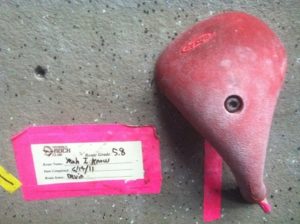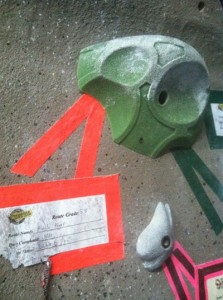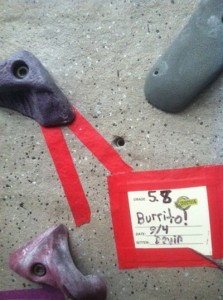 I went to the climbing gym this morning with a mix of anticipation and dread. Anticipation, because climbing has become my newest favorite thing. Dread because my newest favorite thing had been tormenting me with something called, “Yeah, I Know.”
I went to the climbing gym this morning with a mix of anticipation and dread. Anticipation, because climbing has become my newest favorite thing. Dread because my newest favorite thing had been tormenting me with something called, “Yeah, I Know.”
“Yeah, I Know” is one of 103 climbing routes currently plugged into the Triangle Rock Club’s 9,000 square feet of climbing wall. It’s one of the gym’s 14 routes rated 5.8 on climbing’s Yosemite Decimal System, which grades technical climbs (those requiring protection/ropes) from easiest (5.0) to you-gotta-be-kidding (5.13). The Morrisville climbing gym’s routes start at 5.5; thus, 5.8 is relatively easy. For some.
My climbing coach (it’s a volunteer position) Joel Graybeal had spent our last two sessions trying to coax me through “Yeah.” About 10 feet into the climb, the third hand-hold requires a stretch that had thus far eluded me. Another 10 feet above that were two more holds that I could tell would be problematic. For a wall that’s just 25 feet high, that seemed like a lot of challenge.
“The key is not to hesitate,” Joel told me. “Figure out your route beforehand, your handholds and their sequence, as well as your footholds, and don’t hesitate. You hesitate and that burns gas in your tank.” In climbing, an empty tank often translates into a case of “sewing machine legs,” an uncontrollable trembling caused by iffy climbing technique leading to extreme muscle fatigue.
I stood back from the wall and examined the route. That third hold, I couldn’t help but think, would demand a leap of faith in addition to a leap of my right arm. I was reminded of countless instances on the mountain bike when I’d come to a technical downhill stretch and hesitated. Hesitate just once, get intimidated by the challenge, and experience told me I’d be hard pressed to ever clear that section. I didn’t want that following me into climbing. Joel’s words rang: Don’t hesitate.
 The route begins with a one-hold start. (On a climbing wall, routes are marked with colored tape. There may be 30 holds within reach, but only those marked with the right color are “on.” Two pieces of tape near a hold indicates a start; if only one hold is marked, you must start with both hands on that hold.) From the two-handed start, the left hand goes up to a hold two feet above, followed by a right hold that, in the opinion of my right arm, was just beyond reach.
The route begins with a one-hold start. (On a climbing wall, routes are marked with colored tape. There may be 30 holds within reach, but only those marked with the right color are “on.” Two pieces of tape near a hold indicates a start; if only one hold is marked, you must start with both hands on that hold.) From the two-handed start, the left hand goes up to a hold two feet above, followed by a right hold that, in the opinion of my right arm, was just beyond reach.
“Bump up your left foot to the blue nub,” Joel said. “That should get you enough extra height to reach that right hand-hold.” Trouble was, the nub in question was just that, a nub, rounded, perhaps three inches in diameter with precious little purchase. I eyed the nub and the profuse sweat with which I’ve become acquainted in my mid-50s began to flow. Before Joel could say “Don’t hesitate” again, I smeared my left foot atop the nub and, with life imitating art, made a slow-motion lunge for that right hand-hold. There was more to the hold than I thought; my right fingertips wrapped around the fist-size hold and held. Dang! I thought.
That’s one small reach for a middle-age climber, once giant step for a middle-age climber’s confidence.
 I sailed up past the next two challenges, then did another 5.8 climb — Tinsel Tiger — on my first attempt before meeting my next nemesis. Burrito is a 5.8 that Joel, after climbing the route himself, declared “more technical” than my previous 5.8s. Translation: The holds aren’t nearly as generous. I tried Burrito once, fell, then listened as Joel coached me through the proper hand-and-foot sequence for Burrito. We’d been climbing for about 90 minutes and my arms were shot. My mind was ready to give it another shot, but not my body. Next time, I said.
I sailed up past the next two challenges, then did another 5.8 climb — Tinsel Tiger — on my first attempt before meeting my next nemesis. Burrito is a 5.8 that Joel, after climbing the route himself, declared “more technical” than my previous 5.8s. Translation: The holds aren’t nearly as generous. I tried Burrito once, fell, then listened as Joel coached me through the proper hand-and-foot sequence for Burrito. We’d been climbing for about 90 minutes and my arms were shot. My mind was ready to give it another shot, but not my body. Next time, I said.
Next time, I’ll return to take a second bite out of Burrito. A bite full of anticipation, devoid of dread.
One thought on “Yes, I can!”